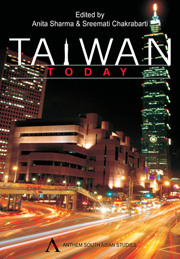Book contents
- Frontmatter
- Contents
- Acknowledgements
- Contributors to this Volume
- Acronyms and Abbreviations
- Foreword
- Introduction
- 1 Who are We? Identity in Transition
- 2 Taiwan: Yearning for an Identity
- 3 The Implications of Direct Flights: Beijing in Taiwanese Politics
- 4 Kuomintang, Democratization and the One-China Principle
- 5 The Deepening and Consolidation of Democracy in Taiwan
- 6 India and Taiwan: Bolstering Complementarity in Information Technology
- 7 Asian Regional Economic Integration and Taiwan–India Economic Relations
- 8 The Taiwan Factor in Sino–Indian Relations
- 9 Japan's Triumphant Diplomacy in Taiwan in 1874
- 10 A Study of the Cultural and Educational Exchanges between Taiwan and India, 1995–2006
- 11 Between Two Worlds: A Survey of Education in Taiwan
- 12 Female Immigrants, Social Capital and Public Sphere in Taiwan
- 13 Information Technology and Gender: Taiwan and India
- 14 Tzu Chi: A Case Study of Engaged Buddhism in Taiwan
- 15 Master Hsing Yun of Fo Guang Shan and the Development of Humanistic Buddhism
- 16 The Heritage and Innovation of Chan Paintings in Taiwan
- 17 Taiwan in World Architecture: A Historical Perspective
- Afterword
5 - The Deepening and Consolidation of Democracy in Taiwan
Published online by Cambridge University Press: 05 March 2012
- Frontmatter
- Contents
- Acknowledgements
- Contributors to this Volume
- Acronyms and Abbreviations
- Foreword
- Introduction
- 1 Who are We? Identity in Transition
- 2 Taiwan: Yearning for an Identity
- 3 The Implications of Direct Flights: Beijing in Taiwanese Politics
- 4 Kuomintang, Democratization and the One-China Principle
- 5 The Deepening and Consolidation of Democracy in Taiwan
- 6 India and Taiwan: Bolstering Complementarity in Information Technology
- 7 Asian Regional Economic Integration and Taiwan–India Economic Relations
- 8 The Taiwan Factor in Sino–Indian Relations
- 9 Japan's Triumphant Diplomacy in Taiwan in 1874
- 10 A Study of the Cultural and Educational Exchanges between Taiwan and India, 1995–2006
- 11 Between Two Worlds: A Survey of Education in Taiwan
- 12 Female Immigrants, Social Capital and Public Sphere in Taiwan
- 13 Information Technology and Gender: Taiwan and India
- 14 Tzu Chi: A Case Study of Engaged Buddhism in Taiwan
- 15 Master Hsing Yun of Fo Guang Shan and the Development of Humanistic Buddhism
- 16 The Heritage and Innovation of Chan Paintings in Taiwan
- 17 Taiwan in World Architecture: A Historical Perspective
- Afterword
Summary
INTRODUCTION
The notion of ‘Taiwanese democracy’ is indeed unique in terms of the pace and process it has gone through. The year 2007 marks the twentieth anniversary of the lifting of Martial Law in Taiwan. Who would have imagined a young democracy like Taiwan to survive all the potential setbacks and growing pains that so-called ‘third wave of democracies’ have endured.
WHO GETS THE CREDIT?
Academic researchers and political analysts often wonder who gets the credit when it comes to the question of Taiwan's democratic opening in the mid 1980s. Some suggest it was the bottom-up approach of the then opposition force, Danwai that pushed towards democratic opening, following the 1979 Formosa incident leading to the establishment of the Democratic Progressive Party (DPP) on 28 September 1986. Some argue that it was Kuomintang (KMT) and a top-down approach that resulted in political democratization. Under President Chiang Chin-kuo, the KMT, reacting to pressure from the DPP, successfully opened party competition and electoral competition. The driving force behind Taiwan's democratic opening shows that it is people power – collective effort made by 23 million people in Taiwan – that has contributed to the emergence of democracy. We are proud to say that today's Taiwan is free from blacklists, political prisoners and religious persecution. Falon Gong is legally protected. Citizens enjoy full civil rights – freedom of speech, freedom of assembly, freedom of expression, freedom of press, etc.
- Type
- Chapter
- Information
- Taiwan Today , pp. 66 - 70Publisher: Anthem PressPrint publication year: 2010



